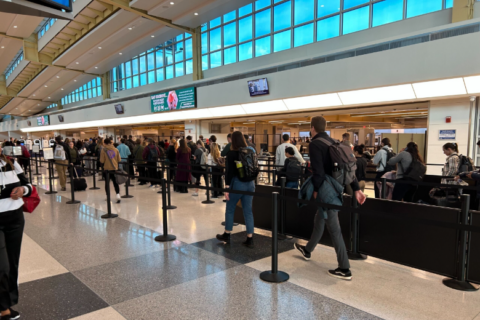In-flight meals haven’t always had the best reputation. Since their inception in 1919, airline fare has often been regarded as something eaten out of desperation on a long flight — a blend of nutritionally devoid starches, inedible meats and highly processed snacks. Thankfully, in-flight cuisine has come a long way over time. The rising number of partnerships with celebrity chefs, a deeper understanding of cooking (and serving) in-flight cuisine and a push for sustainable and nutritional dishes have ushered in a new era of in-air cuisine, far removed from the days of attendants pushing out foil wrapped potatoes and oddly shaped meatloaf.
These days, airlines are welcoming guests with perfectly seared filets of steak or vegetarian noodle dishes spiced with fresh herbs and bowls of creamy curries topped with fresh lobster meat. With the direction the airline industry is moving, believe it or not, you can have first-class cuisine at 35,000 feet in the air. Here’s a primer on the latest trends — and evolution — of airline food.
[See: How to Fly Through Airport Security.]
How Low Pressure and Dryness Affects Our Sense of Taste
The key to understanding the evolution of airline cuisine comes down to understanding the science behind consuming in-flight cuisine — how we actually taste, experience and enjoy food while up in the air. Studies have found that our taste buds and sense of smell are often hindered once we reach 35,000 feet due to low pressure in airplane cabins. As a result, the dining experience is limited, causing the food we consume to taste bland or uninspired. Plus, humidity drops to an all-time low (around 10 — 12 percent in flight), making it harder to smell our food. This paired with the low cabin pressure reduces your taste buds sense of sweet and salty flavors by over 30 percent.
Despite losing much of our ability to taste sweet and salty fare, our sour, bitter and spicy buds remain almost the same up in the air, which is why many airlines tread lightly on preparing overly spicy and overly bitter dishes, such as salads dressed with radishes and vinegar or zesty curries. Instead, chefs are using more powerful herbs, gourmet salts and citrus flavors that don’t overpower our taste buds that are still intact.
Exclusive Chef Partnerships
To help brush away the stigma associated with typical airline dining, some of the world’s premier brands have formed partnerships with critically-acclaimed chefs, not just to elevate their menus, but to serve as brand ambassadors for the new wave of air cuisine. Singapore Airlines, for example, has partnered with New York legend, Alfred Portale, to upgrade the meals in their Suite and business-class cabins to serve five-star, restaurant quality meals. Just as important, they’ve also partnered with renowned sommeliers Jeannie Cho Lee, Michael Hill Smith and Oz Clarke to upgrade the in-flight wine experience as well. Now, you can sip on vintage Dom Pérignon or award-winning Chardonnays while you enjoy your meal.
Finnair, Finland’s primary airline, has also partnered with celebrity chefs for their business-class cabins, introducing Steven Liu from China and Sasa Laukkonen from Finland. “With these new partnerships, we’ll bring the tastes and flavors of the East and West directly to our business passengers,” says Juha Järvinen, Finnair’s chief commercial officer. The carrier’s signature menu, which is served on long-haul flights, features dishes that blend the Nordic style with Eastern flavors.
Though taste is one of the most important components of perfecting airline dining, so is presentation, especially for fliers seated in the plane’s business- and first-class cabins. To bring more of a five-star experience, Singapore Airlines ensures their meal services are treated as such. For Suite passengers, attendants will dress the table in white linens and will provide passengers with a sampling of wines before the meal service begins. When it’s time to dine, the meals are plated just as chefs would in a New York City kitchen, complete with fresh garnishes and beautiful sauce presentations.
[See: 8 Ways You’re Annoying Passengers During the Holidays.]
Seat Upgrades
Business- and first-class cabins have seen a better selection of fare over the years, but most economy-class passengers have been stuck with the same blasé selections. However, top airlines like Finnair, British Airways, Emirates, Singapore Airlines and Virgin Atlantic Airways have completely reinvented their economy menus, offering dishes that combat the lack of taste and smell. British Airways, for example, offers a World Traveler menu that comes loaded with citrus accents, fresh spices and foods rich in umani, a savory flavor that produces a distinct taste and smell (think: tomatoes, parmesan cheese and mackerel).
Along with updated menus, most flights are now offering snack boxes, such as pizza pockets, cheese and nut blends, as an after meal service to all economy passengers. Not only are these complimentary with your fare, they’re also nutritious, offering guests a much-needed energy boost to stay awake to new time zones in long-haul flights. Delta Air Lines passengers, for instance, receive snack boxes complete with hummus, crackers, olives and nuts. And JetBlue Airways offers guests crunchy roasted fava beans, which aren’t just protein packed, but full of healthy antioxidants as well.
[See: 2015-16 Best Airline Rewards Programs.]
Airlines Are Keeping Up with the Latest Food Trends and Diets
Just as restaurants and food trucks continue to keep up with food trends and demand, so do airlines. Instead of the same pasta or chicken, many airlines are offering more trendy options, such as mini sliders with vegetable fries, flourless chocolate tarts with fresh berries or mini cupcakes. More than just adapting to the latest culinary trends though, airlines have taken food allergies far more seriously. While most major airlines always offer a vegetarian meal, some are beginning to offer purely gluten-free, vegan and even paleo options for guests following strict diets. United Airlines, for example, provides a long list of meal options for any dietary restriction, including vegetarian, gluten-free and even kosher choices.
More from U.S. News
How to Master the Seat Upgrade and Auction Game Next Time You Fly
4 Things Every Traveler Should Know About Global Entry
How Upgraded Amenities May Change Air Travel as We Know It
The Latest Trends in Airline Cuisine originally appeared on usnews.com







